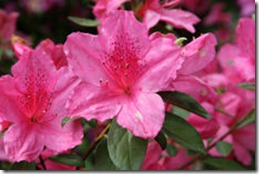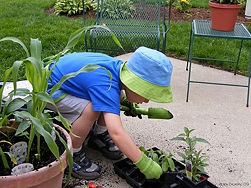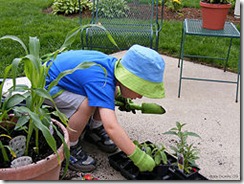Steps
-
1. Purchase a potted flower! You can get it at a retail store or a greenhouse – it’s up to you. Look over the plant well before you purchase it, though, to make sure it doesn’t have pests and that it is healthy and vigorous. If a plant is wilted and has a lot of yellowed leaves, it’s best to pass on it and look for a better specimen. Also check the label to ensure that you’re buying a plant that will survive in your climate zone.
-
Choose your planting area according to the sun/shade requirements of the plant you purchased. Work the soil to a depth of at least 12-18 inches all around the planting area. If the soil is too hard or dry, you can amend it with peat moss, commercially bagged soil, and/or compost to improve the texture. Powdery or extremely sandy soil may too fine or porous to hold water. The other extreme is heavy clay that holds too much water and can smother the roots. You want soil that is crumbly and soft and that can be packed tightly around the rootball.
-
You can add fertilizer if you want your plant to flower more vigorously. Most plants, however, have fertilizer crystals or beads already in the soil when you purchase them. There are products that boost root growth that you can add at the time of planting. Read the label carefully for the appropriate dose. Be sure not to overfertilize, which can burn the plant roots.
-
Dig a hole, about twice as large as the diameter of the flower’s pot. If the plant is rootbound (the roots are tightly wrapped around the rootball), take a sharp garden knife and slit the side of the rootball from top to bottom on at least four sides, also slicing off the bottom of the rootball if it, too, is tangled with roots. Place the plant in the center of the hole. If the roots are loose, spread the roots gently under and around the plant.
-
Spread a layer of loose dirt around the base of the rootball. With your garden hose or bucket, add enough water to cover the dirt. Add another layer of dirt to the hole and more water to cover. Repeat until enough soil has been added to the hole to completely cover the root ball. The soil may be soft and muddy. Let it sit for a bit until the water drains down, and then press down all around the edge of the root ball with your fist or your foot until the plant is tightly held in the hole. Then add dirt up to the point on the stem of the plant where its natural soil line would be (you can usually tell because the stem will be darkened with dirt up to that point and then clean above it). Do not add dirt above the soil line or the plant’s roots may not survive. Press down again all around the rootball.
-
Mulch the plant to a depth of about two inches with a good dense mulch, about two inches out from the stem to the edge of the outer leaves or branchers. Don’t mulch right next to the stem to reduce the possibility of insect or rodent activity. Press down again all around the root ball. To test whether the plant is securely in the hole, grab it at its base and gently tug. If the plant comes loose or wiggles around, you haven’t packed the soil tightly enough. If it holds firm, the plant is situated correctly.
-
Water your plant one more time through the mulch and then periodically every three or four days or so if you find that the soil is becoming dry. Don’t overwater. That can drown the roots.
-
Sun and warmth and the plant’s own energy will do the work from here on out with just a little help from you. Enjoy, because your garden is your sanctuary!
Tips
- If you have pets, enclose the planting area with a barrier that will prevent them
 from trampling the newly planted flowers. You may want to purchase a soil testing kit from a garden center to determine what amendments your soil may need, although generally that isn’t necessary.
from trampling the newly planted flowers. You may want to purchase a soil testing kit from a garden center to determine what amendments your soil may need, although generally that isn’t necessary. - Even if your soil looks good (black, wormy, with consistency not too sandy or clayey), it never hurts to add a bit of compost to the planting area.
Warnings
- Some flowers are poisonous to people and pets, so unless you’re sure, keep kids and animals away from the plant.
- Follow the instructions on the little plastic marker. Specifically, make sure that the flower is planted in sun or shade, depending on what it needs.
Things You’ll Need
- A pair of garden gloves, unless you don’t mind getting your hands dirty
- Your plant
- Fertilizer (optional)
- A garden shovel
- A water source (e.g. a hose, a watering can or bottle)


Deprecated: strpos(): Passing null to parameter #1 ($haystack) of type string is deprecated in /home/agriviek8Qv/agriviet.net/public_html/wp-includes/comment-template.php on line 2522